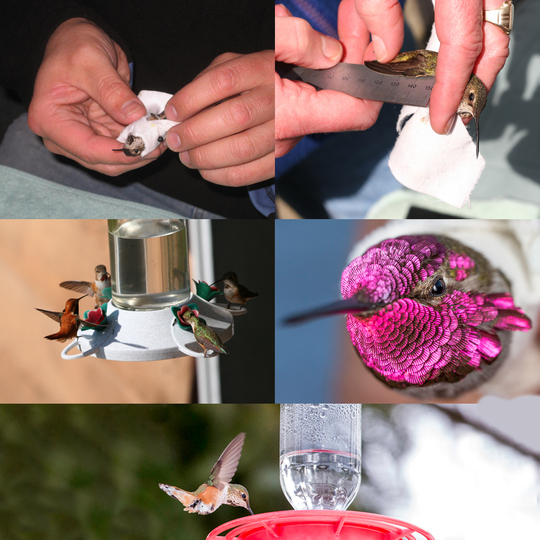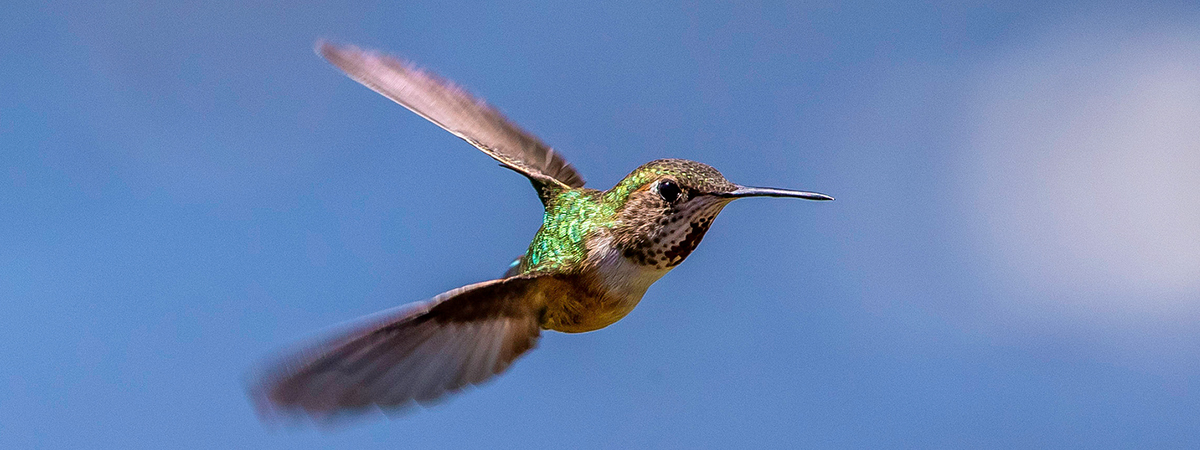
Helping Hummingbirds
Posted by Devin Manky April 9, 2018
It's National Wildlife Week in Canada and to help celebrate the diversity of wildlife on Grouse Mountain we will be posting different blogs throughout the week to highlight some of our wonderful wild animals found around Grouse Mountain and Vancouver and ways that you can help them out from home!
Today we'll start with the amazing hummingbirds. On Grouse Mountain we see two species of hummingbird, the local Anna's Hummingbird (Calypte anna) and the migratory Rufous Hummingbird (Selasphorus rufus). For over the past decade Grouse Mountain has participated in the Hummingbird Monitoring Network - a volunteer driven, science based initiative to study hummingbird population numbers and movements in Western North America. Before this initiative there was relatively little studied information available.
As part of the network Grouse Mountain runs and maintains a hummingbird feeding station with five feeders. From the time that we first see Hummingbirds on the mountain (which can range in dates from April until June depending on conditions) we begin to carry out monitoring sessions every two weeks until the birds leave again (usually late August). During these monitoring sessions we count the number of birds coming to the feeders (or just observed nearby) and then safely catch the birds using a special 'trap' designed to prevent the birds from flying away until they can be picked up by trained handlers and evaluated. We take measurements of the birds wings, beaks, feathers and look at the bird's sex, age, body condition and fat levels. We can also tell if the birds are in breeding condition or are even in the process of egg laying. All of this info is carefully recorded and a small band is placed on the birds leg. This information is then shared with the Canadian Wildlife Service, and the USA equivalent, so that if that hummingbird is found at another station we will know where they have moved to and how much time has passed since the bird was banded.
Through the efforts of Grouse Mountain and the other stations in the network we have been noticing an unfortunate decline in the numbers of Rufous Hummingbirds (a species the network focuses on). The thought is that much of the birds migratory routes are being developed and many of the resources they use for feeding along the route are being removed during land development. This is still under study, however.
Speaking of available resources, there are some great ways that you can help out hummingbirds at home and be an ambassador for these little wonders. Perhaps the easiest way is to plant flowering bushes and shrubs that will serve as natural food for the birds as they migrate and set-up breeding territories. Hummingbirds love flowers such as lupine, honeysuckle, columbine, bee balm and other flowers with a deep cup shape and lots of nectar. It will also enhance your yard and house!
To assist the flowers you can also easily set-up and maintain one or more hummingbird feeders too. They are easily purchased in most home and garden stores or online. Look for ones that come apart easily for cleaning, have a clear coloured jar for feeding (to make sure it's clean), a red or brightly coloured base and one that has perches near the feed openings as hummingbirds do like to rest while they have a bite to eat!
After purchasing a feeder, give it a good clean and rinse with warm water and anti-bacterial detergent. When looking for a location to hang it please take into consideration features like window sills, fences, posts or other areas that might be easy perches for local house cats or other predators. If the feeder is too close to these items it can be a risk that predators will learn they can feed on the hummingbirds coming to the feed station. Make sure there is also a bit of distance from any windows to prevent accidental window strikes as hummingbirds can get quite jumpy at the feeders if there are other hummingbirds around (they are highly territorial). If you live in bear country please hang the feeder far enough off the ground to prevent it becoming an attractant - bears have a sweet tooth and love sugar water too!
Finally, fill the feeder with a water and sugar solution. The most common is 3 parts water to 1 part sugar. Boil the water you plan to use for about 15 minutes to kill any bacteria that might be present. This will also boil off any chlorine or other chemicals used in the water treatment process. Do not add the sugar when the water is at a boil as this can cause some molecular damage to the sugar which makes it harder to digest - wait until the water cools slightly but is still quite warm and then add the sugar. Stir until it is dissolved. The feeders do not have to be completely full and you should only use enough sugar water that might be eaten over the next few days as it is important to keep the feeders clean, especially in the heat of summer. No red dye or other colours should be added to the sugar solution - there can be complications to hummingbirds who feed on coloured water due to the chemicals involved. The natural nectar from flowers is clear and so should your solution. The red base of the feeder will be the attractant to lure the birds in.
To prevent bacterial build up it is recommended to clean the feeders and fill with a new solution every couple of days during the hot months and at least once a week during the colder months. Use a jar scrub brush to reach right in and clean the feeder well - pipe cleaners or small brushes can be used to clean the feeding holes around the bottom.
It can be a really rewarding experience to maintain a hummingbird feeder! Hummingbirds have fascinating behaviors, sounds and body posturing that make for fascinating viewing. If it is your first time setting up a feeder do not be discouraged if the birds do not find it right away - it can sometimes take a couple seasons (years) before the feeder is found but once it is then attendance will grow year after year from there.
You can also partake in some backyard science yourself and keep records on what date each year you see the first returning migratory bird and the last day you see birds before they are gone for the winter. Records of how much sugar water is used can also be helpful as it can be estimated how many birds are feeding off of that.
Enjoy these marvelous bundles of energy and be an ambassador for their species by telling others of their plight and of the ways that they can help them out. Also be sure to stop by our Hummingbird Garden and feeding station the next time you are up on Grouse Mountain - it is located on the Peak side of our mountaintop plaza outside of the chalet. Now we wait for the first birds of the year!

